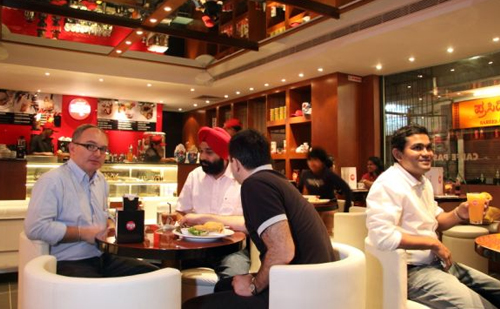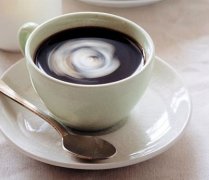Coffee Encyclopedia: coffee Culture in five different countries
Coffee culture has a long history, and the long history has accumulated the profound heritage of the world coffee culture, and the coffee culture of various countries is even more colorful. Let us take you into this colorful journey of world coffee culture and show you the essence of coffee culture of five different countries.
French coffee culture
I have heard that France once drank less coffee because of a shortage of coffee, and immediately saw more people taking a nap. It may seem like an exaggeration, but it is true that the French are addicted to coffee. When the "Gulf War" broke out in 1991, France was also one of the countries participating in the war. some ordinary people in China worried that the war would affect the supply of daily necessities and rushed to supermarkets to buy them. Even the TV station was alarmed by the fact that when the camera looked at customers who were full of "scarce supplies," they found that what they got the most was coffee and sugar. At one point, it became a big joke at that time.
The French do not seem to pay attention to the taste, but the environment and atmosphere. Most of them do not want to drink alone behind closed doors, but join in the fun outside, even if the price of a small cup is enough to make a pot at home. They did not drink hurriedly, but tasted slowly, tasted carefully, read books and newspapers, talked about it, and drank it for most of the day. French people develop this habit of drinking coffee, whether they consciously express a kind of elegant charm, a kind of romantic sentiment, a kind of freehand feeling of enjoying life. It can be said that this is a traditional and unique coffee culture. Because of this, the places where people can rest and drink coffee in France can be said to be all over the streets, roadsides, squares, riverbanks, cruise ships, and even the Eiffel Tower. And the form, style, size are not limited to one style, there are coffee shops, restaurants, halls, rooms. And the most popular and romantic ones are those open-air cafes, which are almost a portrayal of French life. No wonder the tasteful French have a traditional saying that it may be more difficult to get someone to change a cafe by the Seine than to change a religion! In an authentic cafe, regular customers not only never change their coffee shop easily, but also have a fixed time to come to the cafe and the habit of which coffee table to sit on. Of course, this loyal relationship is also reflected in the hospitable and tireless host, without greeting, the old waiter who is familiar with his frequent customers' temper and hobby will bring his favorite kind of coffee, accompanied by a plate of special snacks, and even bring his favorite newspapers and periodicals, needless to say thank you, which are taken for granted in an authentic cafe.

Italian coffee culture
There are two things to be careful when you go sightseeing in Italy: one is a man and the other is coffee. In Italy, coffee and men are actually two different things, so there is a famous Italian saying: men should be like good coffee, both strong and enthusiastic! Italian coffee, named Espresso in English, has been widely known by coffee lovers in China in recent years. This kind of pure black coffee, which is thick and fragrant, with a layer of golden foam floating on its surface, is thick and hot like a devil escaped from hell. It is often called to drink and falls into unspeakable charm and unforgettable. The characteristic of Italian coffee is that it is a fast word in its English name; it can be cooked no more than ten seconds and drank quickly, because there are only two or three mouthfuls. Most Italians make a cup of coffee as soon as they get up. Men and women drink almost from morning till night. A small coffee shop called BAR can be seen everywhere on the street. It sells about 400 lira for people to drink standing up.
On average, Italians drink 20 cups of coffee a day. The coffee beans that make Italian coffee are the most fried beans in the world. This is in line with the special function of the Italian coffee pot to instantly extract coffee. This kind of strong-looking coffee doesn't hurt the intestines and stomach at all, and it even helps digestion. There is also a way to drink Italian coffee with milk, called Cappuccino, which uses steam above 130 degrees Celsius in an Italian coffee pot to first foam the milk and then float on the thick black coffee. Sweet fresh milk, pure white lovely; charming Espresso devil under its embellishment, immediately transformed into a wonderful angel!
American coffee culture
When Americans drink coffee, it is like playing a game without rules, laissez-faire without taboos. Americans are dismissive of all kinds of exquisite coffee made by Europeans. Americans drink coffee freely, and at the same time, coffee goes deep into their lives and is difficult to separate, and the influence is so deep that it is not considered a life without coffee. It is said that the Apollo 13 spacecraft, which carried a man to the moon for the first time, had a life-and-death failure on its way home. At that time, the ground crew comforted the three astronauts by saying: come on! Delicious hot coffee is waiting for your return. Americans can't do without coffee almost 24 hours a day, whether at home, in the office, in public, or at a roadside vending machine. This consumes 1/3 of the world's coffee production and is the country with the largest coffee consumption in the world. Generally speaking, life in the United States is rather busy and tense, unlike people in Europe and the Middle East who can enjoy life in a leisurely mood. When drinking coffee, it is often a large pot of electric filter coffee, from morning to night, because there is too much water and less coffee. The taste is particularly weak, so many people criticize that American coffee is really bad. In fact, in all parts of the United States, coffee lovers can still taste their favorite coffee taste with a little more effort. If pure American coffee is divided into two categories, the east coast of the United States is stronger than the west coast, and the south is stronger than the north. Ethnically speaking, immigrants from southern Europe and Latinos prefer strong coffee to those from Britain, Germany and northern Europe. In addition, although the United States is the largest exporter of instant coffee, not many people in the United States drink instant coffee. In recent years, they pay more and more attention to the results of a healthy diet, the market for caffeine is increasing, and coffee without sugar is becoming more and more common.
Turkish coffee culture
Coffee in the ancient Middle East, like the legendary myth of the 1001 night, is a veiled girl with a thousand faces, which can not only help get close to God, but also wash the spring of sadness. When it comes to coffee, we have to mention the Middle East (Turkey) coffee, because whether from the perspective of Islam or Christianity, the origin of coffee is in the remote and mysterious mountains of the Middle East. After three hundred years of banning roles in Muslim religious circles in the 13th and 15th centuries, coffee was officially introduced into Turkey in the 16th century, began to be commercialized, and quickly spread to the European continent. This coffee drinking method, commonly known as Turkish coffee or Arabica coffee, which is popular in Greece, Eastern Europe, the Middle East, and North Africa, still retains the mystery of early religious rituals. As the local people drink coffee is not filtered, this cup of coffee, which is as thick as broth, is poured into the cup, with sticky foam on the surface and dregs at the bottom of the cup. In the Middle East, being invited to someone's house for coffee represents the most sincere respect of the host, so in addition to praising the mellow coffee, guests should also remember not to drink water even if they are full of dregs, because it implies that the coffee is not good. Arabs drink coffee slowly, and they even have a set of exquisite coffee ways, just like the Chinese tea ceremony, when drinking coffee, they not only burn incense, but also sprinkle spices and smell incense, and have a dazzling array of coffee pot utensils. it is even more full of Arabian Nights style. A cup of Middle Eastern coffee with cloves, cardamom and cinnamon is full of fragrance when it is hot. No wonder Arabs praise it: musk attracts the heart and soul.
Japanese coffee culture
The first coffee spread to Japan was Nagasaki in the Yuanlu period. And people officially accepted it from the Meiji era. Now let's take a look at the coffee history of Japan. It tastes mellow and the Japanese are not used to the successive opening of coffee houses in Western Europe, when the literature and art of coffee culture are in bloom, while Japan is in the midst of the strict enclave policy of the Edo era. Coffee, the first drink at that time, was set up at the Dutch store off the island of Nagasaki (1641) and presumed to have been brought in at that time. However, those who can get in touch with foreigners are servants (officials), businessmen, interpreters and tourist girls. Two or three interpreters of Zunberu's Journey to Japan recorded in 1776 finally knew the delicacy of coffee. The "coffee" that specially spread to the island to symbolize foreign culture could not be popularized at that time.
The Japanese drink coffee is a crazy singer and opera writer in 1804. In the book Qiongpu and Qiongpu, the people of Shushan in Daejeon were invited to drink coffee on a red-haired boat. the beans were fried black and powdered and mixed with white sugar. the bitter smell and bitterness can not adapt to the taste. " Judging from the background in which coffee is imported from the island and is not widely accepted, the policy of locking up the country has indeed affected the Japanese people's unaccustomed to the taste of the new drink.
At present, the competition in the Japanese coffee market is quite fierce, including ordinary coffee and instant coffee, home coffee and office coffee, all kinds of canned coffee, plus hospitable coffee, delicious coffee and so on. In particular, the more authentic demand for coffee in the Pyeongcheng era has also increased.
Important Notice :
前街咖啡 FrontStreet Coffee has moved to new addredd:
FrontStreet Coffee Address: 315,Donghua East Road,GuangZhou
Tel:020 38364473
- Prev

New information in the industry: the magical effect of coffee beauty
Coffee beans are of great value to the body. Caffeine in coffee beans, as the most important ingredient, can promote lymphatic circulation. In addition, coffee also contains other useful ingredients, such as organic acids, fatty acids, alkaloids, minerals, potassium, magnesium, iron and so on. The coffee bean product line represented by the brand Pascucci is particularly famous, which is used in most brand cafes around the world.
- Next

Industry information: the close relationship between coffee and health
Coffee has always been loved by people, and the process of coffee has gone through countless ups and downs for more than one year. Recently, the substantial health issues surrounding coffee and health have once again aroused discussion among people inside and outside the industry. Here are two important questions: does drinking coffee affect sleep? Many people have the experience of being too excited to sleep after drinking coffee, because there is a
Related
- Beginners will see the "Coffee pull flower" guide!
- What is the difference between ice blog purified milk and ordinary milk coffee?
- Why is the Philippines the largest producer of crops in Liberia?
- For coffee extraction, should the fine powder be retained?
- How does extracted espresso fill pressed powder? How much strength does it take to press the powder?
- How to make jasmine cold extract coffee? Is the jasmine + latte good?
- Will this little toy really make the coffee taste better? How does Lily Drip affect coffee extraction?
- Will the action of slapping the filter cup also affect coffee extraction?
- What's the difference between powder-to-water ratio and powder-to-liquid ratio?
- What is the Ethiopian local species? What does it have to do with Heirloom native species?

